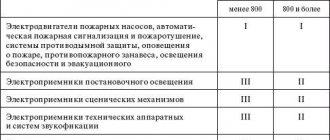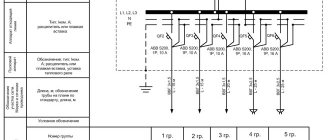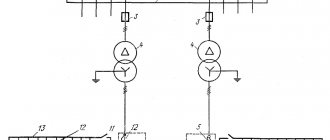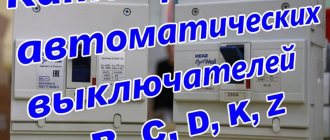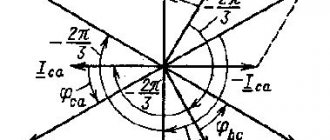Determination of power supply category
With regard to ensuring the reliability of power supply, power receivers are divided into the following three categories:
Electric receivers of category I
- electrical receivers, the interruption of power supply to which may entail: danger to human life, significant damage to the national economy; damage to expensive capital equipment, mass defects of products, disruption of a complex technological process, disruption of the functioning of particularly important elements of public utilities.
From category I electrical receivers, a special group of electrical receivers is distinguished, the uninterrupted operation of which is necessary for an accident-free shutdown of production in order to prevent a threat to human life, explosions, fires and damage to expensive capital equipment.
Category I power receivers must be provided with electricity from two independent, mutually redundant power sources, and an interruption in their power supply in the event of a power failure from one of the power sources can be allowed only for the duration of automatic power restoration.
To supply power to a special group of category I electrical receivers, additional power must be provided from a third independent, mutually redundant power source. Local power plants, power plants of power systems (in particular, generator voltage buses), special uninterruptible power units, batteries, etc. can be used as a third independent power source for a special group of electrical receivers and as a second independent power source for the remaining electrical receivers of category I. .
If power supply redundancy cannot ensure the necessary continuity of the technological process or if power supply redundancy is not economically feasible, technological redundancy must be implemented, for example, by installing mutually redundant technological units, special devices for emergency shutdown of the technological process, operating in the event of a power supply failure.
If feasibility studies are available, it is recommended that power supply to category I electrical receivers with a particularly complex continuous technological process requiring a long time to restore the operating mode be carried out from two independent mutually redundant power sources, which are subject to additional requirements determined by the characteristics of the technological process.
Electric receivers of category II
— electrical receivers, the interruption of power supply to which leads to a massive shortage of products, massive downtime of workers, machinery and industrial transport, disruption of the normal activities of a significant number of urban and rural residents. It is recommended to supply power receivers of category II with electricity from two independent, mutually redundant power sources.
For category II electrical receivers, in the event of a power failure from one of the power sources, interruptions in power supply are allowed for the time required to turn on the backup power by the actions of the duty personnel or the mobile operational team.
It is allowed to supply power to category II electrical receivers using one BJI, including those with a cable insert, if it is possible to carry out emergency repairs of this line in no more than 1 day. Cable inserts for this line must be made with two cables, each of which is selected according to the highest continuous current BJI. It is allowed to supply electrical receivers of category II via one cable line, consisting of at least two cables connected to one common device.
If there is a centralized reserve of transformers and the possibility of replacing a damaged transformer in no more than 1 day, it is allowed to supply category II electrical receivers from one transformer.
For category III electrical receivers, power supply can be provided from a single power source, provided that power supply interruptions necessary to repair or replace a damaged element of the power supply system do not exceed 1 day.
Electric receivers of category III
- all other electrical receivers that do not fit the definitions of categories I and II.
Third category
This type includes all enterprises and other energy receiving devices that do not fall into the first and second categories.
These include:
- Enterprises and city institutions, interruption of power supply, which will not cause significant losses.
- Small settlements, dacha cooperatives, garages, cottage communities.
- This reliability is suitable for individual housing construction, administrative buildings, for a private house or for an apartment building.
All consumers are connected to one source of electricity. As shown in the diagram below.
Power outages are allowed for no more than 24 hours. This time is necessary for the emergency crew to carry out repair and restoration work.
Second price category of electricity
The optimal price category for those who work only at night.
The electricity tariff depends on the time of day:
- Day and night.
- or Peak, Half Peak and Night.
You can choose for yourself which option suits you best.
Electricity cost calculation =
night tariff for electricity * consumption according to the meter at night
+ daily electricity tariff * consumption by meter during the day
Conditions:
- power up to 670 kW
- multi-tariff meter that keeps records by day zones
Advantages: Optimal tariff for small organizations with a night work schedule.
Flaws:
- Very high price for electricity during the day.
- Calculation for power occurs on the residual principle.
- Not suitable for organizations that work day and night.
The second price category is suitable for organizations that work only at night, such as bakeries, or for organizations that can completely switch to a night work schedule.
An example of cost calculation for the second price category is at the link.
Calculation of the fifth and sixth price categories of electricity
Calculation for the fifth and sixth price categories is carried out using a similar method as for the third and fourth price categories with only one difference:
The price for consumed electricity will be 5%-7% lower if you are included in your forecast and 5%-7% higher if you are not included in the forecast.
For simplicity, let's stop here - if you are confident in your forecast, then at 5 - 6 price categories you will be able to save another 5% compared to 3 and 4 price categories.
Now let's summarize - what price category is suitable for the enterprise in our example.
First price category = default price
Anyone who has not chosen anything is served here.
In the first price category are all small organizations that did not express any preferences at the time of concluding an electricity supply agreement with a supplier of last resort.
Calculating the cost for the first price category is very simple.
Electricity cost calculation = electricity tariff * meter consumption
Conditions: power up to 670 kW
Advantages: None
Disadvantages: Calculation for power occurs on a residual basis.
After the population and consumers in other price categories have paid, the entire cost of uncovered capacity in your region falls into the bills of consumers in the first price category.
Exceptions: In some regions, distortions periodically occur when consumers in 3-6 price categories pay for the entire power of the region.
In these cases, consumers in the first and second price categories do not pay for power and the cost of electricity for them becomes lower than for consumers in the “correct” 3-6 price categories.
An example of cost calculation for the first price category is available at the link.
Allowable power outage and restoration time
The conditions for providing electricity are specified in the supply contract. It indicates the reliability of the system, the outage time per year and the period for completing repair work. These parameters are regulated by the PUE.
Consumers of the first and second reliability categories determine the timing depending on the electrical network diagram and the availability of a backup power source. However, they should not exceed the norm provided for consumers of the third category.
For them, a one-time power outage should not exceed 24 hours. At the same time, annual shutdowns are also regulated. It is 72 hours.
Electricity price categories: Fourth
The fourth price category is very similar to the third with one big difference: payment for electricity transmission occurs at a two-rate tariff.
At a two-rate tariff for electricity transmission, the cost of maintaining electrical networks and the cost of electricity losses in the networks are paid separately.
Electricity cost calculation =
amount (electricity tariff for each hour * meter consumption per hour)
+ maximum power * power cost
+ two-part tariff for transmission.
Conditions: Metering device with hourly metering of electricity consumption.
Advantages:
- Separate payment for consumption and power, which makes it possible to control maximum power.
- Payment at the market rate for each hour, which makes it possible to fine-tune the work schedule.
- Separate payment for the cost of maintaining electrical networks and the cost of electricity losses in the networks is the best option for enterprises with a very stable load schedule.
Flaws:
- Not suitable for businesses with uneven load, such as high consumption during the day, low at night.
- Not suitable for enterprises that operate, for example, in one shift.
- Not suitable for enterprises that cannot plan their work at all (there are orders, sometimes there are no orders).
An example of cost calculation for the fourth price category is available at the link.
Calculation of the fourth price category of electricity
The third and fourth price categories of electricity differ from each other only in the cost of electricity transmission services.
In the fourth price category, the enterprise pays a two-part tariff - electricity losses and the cost of maintaining networks are paid separately.
Rates for the Two-Part Tariff can be found at Find a Guarantee Supplier or Service at the rates of your region.
In our case:
- Two-part tariff - payment of losses - 0.35 rubles/kWh
- Two-part tariff - maintenance rate - 600 rubles / kW
To calculate the cost of a two-rate tariff, we need one more indicator - network capacity.
Network power (or maximum power during peak hours) is calculated as follows:
We find the planned peak load hours for the month we are interested in on the website of the System Operator of the Unified Energy System. For example, here are the peak hours for 2020.
For example, our peak hours were from 8:00 to 18:00.
Now we need to find our maximum hourly consumption in this interval for each working day.
For example, for the first day it is 130 kWh, for the second 170 kWh, etc.
We sum up all the found indicators and divide by the number of working days - this is our network capacity for the month.
In our example, the network power is 150 kW.
Now we have all the indicators to calculate the cost of electricity transmission at a two-rate tariff.
Cost of transmission services at a two-rate tariff = metered consumption * payment for losses + network power * maintenance rate = 100,000 kW*h * 0.35 RUR/kWh + 150 kW * 600 RUR/kW = 125,000 RUR
We calculate the cost of electricity in the fourth price category:
Cost of electricity in the fourth price category = Cost of consumption + Cost of power + Cost of transmission services = 150,000 rubles + 105,000 rubles + 125,000 rubles = 380,000 rubles
